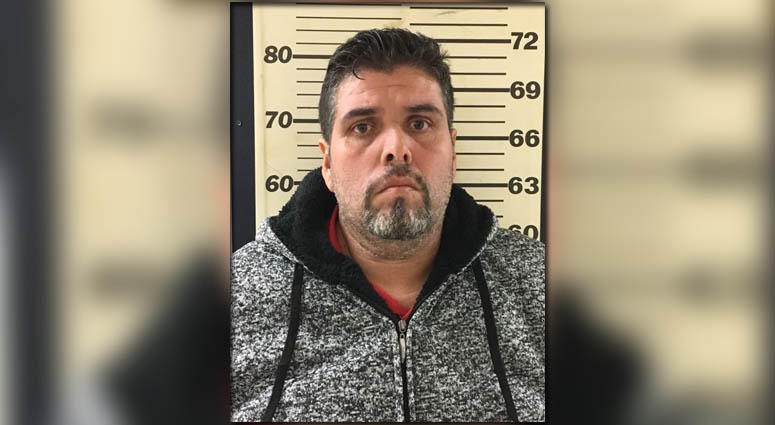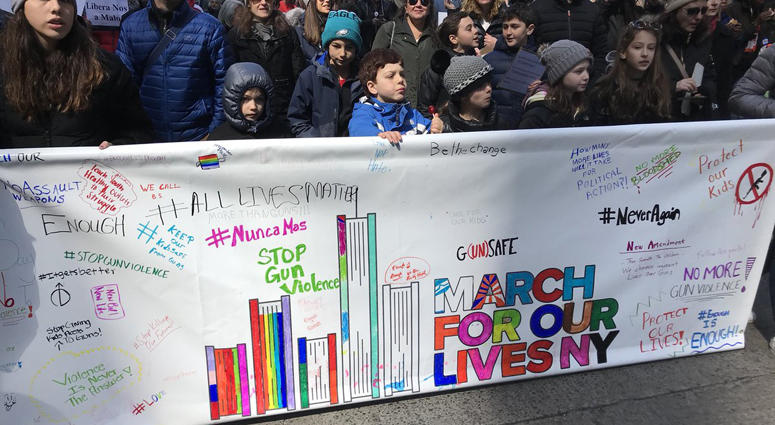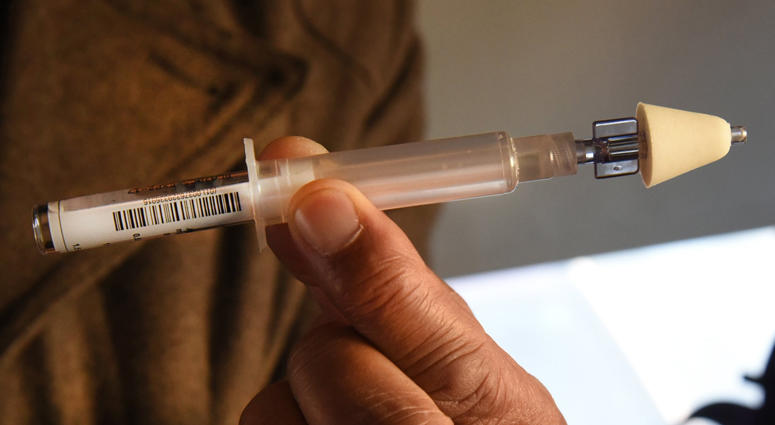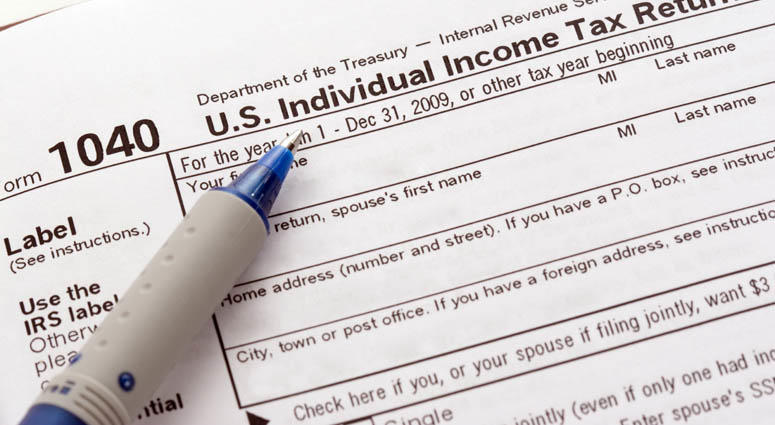
Lee Brice: Garth Brooks is my hero | Kurt's Country
Neil A. Carousso produces NewsNation original “Kurt’s Country” – a celebration of country music and a slice of Americana with host Kurt Bardella.
-
Prosecutor: Mexican Drug King, Alleged Underlings Brought Enough Fentanyl Into NYC To Kill Millions
Post Views: 1,399NEW YORK (WCBS 880) — A Mexican drug kingpin and five others were indicted Tuesday in an alleged drug smuggling conspiracy, which authorities said brought enough fentanyl into New York City to kill 10 million people.
In the indictment filed by the New York City Office of the Special Narcotics Prosecutor, Francisco Quiroz-Zamora, 41 – also known as “Gordo” – was charged with operating as a major trafficker, conspiracy, and criminal sale of a controlled substance.
An indictment alleged Quiroz-Zamora, of the Sinaloa Cartel, was the Mexican-based source of a recent large shipments of fentanyl to New York City, and alleged that
A resident of San José del Cabo, Mexico, Quiroz-Zamora allegedly arranged for narcotics to be smuggled from Mexico to Arizona and California on trucks and cars and with drug couriers. He allegedly communicated directly with New York City drug customers, and arranged for members of his trafficking network to conduct drug deals, prosecutors said.
“Kingpin or major trafficker charges carry a life sentence, and that’s important because he had direct dealings from Mexico with a distribution network in New York City and with an undercover officer, and he was responsible for sending to New York City at least 50 pounds of fentanyl, which is charged in the indictment,” New York City Special Prosecutor Bridget Brennan told WCBS 880 Producer Neil A. Carousso. “And you know, fentanyl is so deadly. It’s viewed to be responsible for what will probably turn out to be a record-breaking number of overdose deaths here in New York City in 2017.”
Quiroz-Zamaroa was charged in connection with a bust that netted 44 pounds of fentanyl at the Umbrella Hotel in the Bronx on June 19 of last year, and on Central Park West on Aug. 4 of last year, prosecutors said.
He received about $22,500 from an undercover officer through a Western Union wire transfer, and came to New York City on Nov. 27 of last year to collect more money from the undercover officer, prosecutors said. But agents tracked Quiroz-Zamora’s movements as he took a circuitous route from Texas to Connecticut by plane, down to Delaware, and then to New York on an Amtrak train, prosecutors said.
Quiroz-Zamora was arrested at Penn Station on Nov. 27 and was originally charged in a complaint in Manhattan Criminal Court. He has been in custody since Nov. 29.
Prosecutors said they also busted a stash house on Central Park West at 105th Street, which was receiving the drugs that were being supplied by the defendants.
“What we found there was it was basically a packaging location; that the people inside that location were packaging many, many thousands of little glassines that were being filled with fentanyl or heroin, and some kind of other substance, and then ultimately, the stuff was headed for street distribution, and that was in a lovely Central Park West apartment with many other people living inside, and when you think about it, it’s a very dangerous situation,” Brennan said.
Five other defendants were also charged in the indictment. Prosecutors alleged that Carlos Ramirez, 27, of Colorado, was caught in a bust with an undercover officer; Jesus Perez-Cabral, 20, maintained the Central Park West drug stash along with Johnny Beltrez, 33; David Rodriguez, 32, was seen carrying suspected narcotics into a car outside the Central Park West building; and Richard Rodriguez, 43, was an Uber driver who drove off with the drugs.
Brennan emphasized that her office is cracking down on fentanyl, with overdoses having reached an all-time high of 1,400 deaths in 2017. Seizures also spiked by a factor of more than 12, from 35 pounds in 2016 to 491 in 2017.
Brennan explained that fentanyl is about 50 times more potent than heroin, and is also cheaper to wholesalers – making dealing in it an attractive proposition for drug traffickers.
“Because it’s a synthetic drug, it’s probably a tenth of the cost of heroin. And so, what we are seeing is that the cartel is sending to the U.S. fentanyl in place of heroin sometimes, or it’s sending up a load that mixes fentanyl with heroin. Heroin being much more expensive, the fentanyl allows them to make a whole lot more money, since when the buyers are buying the little packages in the street, they don’t know whether it contains fentanyl or heroin – it could be either – but they’re going to be paying the same price regardless,” Brennan said. “So it really enhances their ability to make a buck.”
Brennan emphasized that millions could have been killed with the amount of fentanyl the drug traffickers brought to the city.
“Millions, I mean, if they were people who were not tolerant of opioids; who hadn’t been using for some time, it would kill many, many people, because the amount of fentanyl which would kill someone who is not accustomed to any kind of opioid really would fit on the tip of your little finger, so think about it – we seized 400-plus pounds; nearly 500 pounds,” she said. “Think of how much damage that would do.”
Brennan added that her office will be going after everyone in the chain of distribution of such dangerous drugs, but will not stop until finding and prosecuting the top suppliers. She emphasized how dangerous – and how disturbingly commonplace – fentanyl has become.
“Fentanyl is now being mixed in with cocaine. It’s being pressed into counterfeit pills. And so anything on our city’s black market could be tainted with this stuff, and it could kill you. So people have to be very, very careful,” she said. “I think prevention messages are very important. I think people need to become educated and recognize that this stuff can’t be played with.”
-
March For Our Lives: In Sound
Post Views: 1,354NEW YORK (WCBS 880) — Hundreds of thousands gathered across the country to demand gun reform.
Listen back to our coverage of the March for Our Lives Rally in Washington, D.C. and here at home:
CBS Correspondent Bill Rehkopf reports from Washington, D.C. where Parkland survivors take the stage and speak out on gun reform:
CBS Correspondent Bill Rehkopf reports on the March For Our Lives in Washington, D.C., where thousands gathered against gun violence:
WCBS Reporter John Metaxas walks alongside crowds of demonstrators who are calling for gun reform at New York City’s March For Our Lives:
WCBS Reporter Ethan Harp speaks with the organizer of New York City’s March For Our Lives:
WCBS Reporter Ethan Harp listens to Governor Cuomo speak on gun reform at New York City’s March For Our Lives:
CBS Correspondent Bill Rehkopf reports from Washington, D.C. where the March For Our Lives has brought massive crowds calling for an end to gun violence:
CBS Correspondent Don Dahler talks gun laws, the possibilty for reform and the place of the Second Amendment in history:
WCBS Reporter Ethan Harp covers New York City’s March For Our Lives where student protesters are calling for gun control following the Parkland massacre:
WCBS Reporter Ethan Harp meets demonstrators at New York City’s March For Our Lives on Saturday, March 24:
CBS Correspondent Bill Rehkopf reports from Washington, D.C. where the protesters are demanding gun control at the March For Our Lives:
WCBS Reporter Ethan Harp speaks to Long Island high schoolers who are rallying for gun reform at New York City’s March For Our Lives on Satuday, March 24th:
Rep. Peter King (R-NY) joins WCBS Newsradio 880 Anchor Cheryl Simone live as “March for Our Lives” protesters gather around the nation to call for gun control measures. Congressman King says it shouldn’t be a Democrat vs. Republican issue or a “gun or anti-gun issue.”
Neil A. Carousso produced WCBS Newsradio 880’s breaking news coverage of the nationwide “March for Our Lives” protest on Saturday, March 24, 2018. All live interviews and content were produced, written and booked by Neil A. Carousso.
-
NYC Steps Up Fight Against Opioid Crisis
Post Views: 1,382NEW YORK (WCBS 880) — This week, Mayor Bill de Blasio announced $22 million more will go to fight opioid overdoses in New York City.
That brings total funding for the HealingNYC program, which was estabished last March, to $60 million.
“We are expanding things that are working and we are also adding some new interventions,” New York City Health and Human Services Deputy Mayor Dr. Herminia Palacio tells WCBS Newsradio 880 Producer Neil A. Carousso. “This is a complex problem and as we learn things we’re adding things to help address it.”
City officials say more New Yorkers die from drug overdoses than suicides, homicides and car crashes combined.
Palacio says HealingNYC aims to reduce opioid overdose deaths 35 percent by 2022.
“We’re starting to see a flattening across the city, from 2015 to 2016 we saw a very rapid increase in the number of opioid deaths by about 50 percent — this increase was largely related to the rapid introduction of fentanyl into the drug supply system and after we initiated HealingNYC we’re very optimistic that we’ve seen a flattening,” Palacio said. “The increase from 2016 to 2017 was only about 5 percent so we still have much, much work to do but we are hopeful that some of our work is really starting to get some traction.”
The next step is more access to naloxone, the life-saving drug that opens receptors in the brain that close when someone uses a drug like heroin. People stop breathing when the brain’s receptors close.
The city Health Department is visiting independent pharmacies throughout the five boroughs over the next month to encourage them to offer naloxone, also known as narcan.
“We have already distributed 100,000 naloxone kits through HealingNYC,” Palacio said. “We have good partnerships with many of the chain pharmacies but in New York City, especially in the boroughs, there’s many independent pharmacies that are still very vibrant parts of the communitiy and through this next initiative the Department of Health is working with approximately 800 independent pharmacies to make sure that they’re aware of the commissioner’s order to make sure that they feel comfortable giving naloxone to people who seek it without a prescription.”
Palacio says the goal of this HealingNYC initiative is to put the life-saving drug in the hands of regular people who can save a life before medics can get to the person.
“So that people can protect themselves, protect their friends, protect their family members. We can’t get you to treatment if you suffered a fatal overdose,” Palacio said. “So this is really about saving a life.”
Individuals seeking support or treatment for themselves or their loved ones can contact NYC Well by calling 1-888-NYC-WELL, texting “WELL” to 65173 or going to nyc.gov/nycwell.
-
Scams To Watch Out For This Tax Season
Post Views: 1,520NEW YORK (WCBS 880) — The IRS has released its updated 2018 list of the top 12 or “dirty dozen” tax scams.
Will Cheung, assistant special agent at the Internal Revenue Service New York Field Office, recently told WCBS Newsradio 880 Producer Neil A. Carousso how to protect your personal information when it has become increasingly difficult.
‘Dirty Dozen’ List Of Tax Scams For 2018
Among the scams to watch out for this year are phone scams, phishing schemes, identity theft, fake charities, and false income.
Phone scams are especially common, with people getting calls from someone purporting to represent the IRS and sometimes threatening taxpayers with police arrest, deportation, or license revocation.
“The thing is we do call people, but we will never threaten somebody, and we will never demand payment. So how these scams work is you get an unsolicited call from a person purporting to be an IRS official, and they demand money, and they want you to pay them right away, and they have this sense of urgency to get you to pay,” Cheung said.
Cheung noted that the first attempt to contact someone will be by postal mail.
“Our first contact will usually be by IRS notice, so it will be sent to your mailing address that you have on file with the IRS,” he said.
If people have mistakes on their returns, they should call the IRS themselves rather than taking a call from someone claiming to represent the organization. Scammers can even manipulate phone numbers on caller ID to make it appear as if the call is from the IRS – a practice called spoofing.
“A lot of these scammers are very tech savvy, so they’re able to do this, and to make it look like it’s really coming from the IRS,” Cheung said. “But again, be wary of these phone calls that you get. I mean, most people know, but you know, even though most people know, there are a percentage of people who don’t know. For example, since October 2013, there’s been 12,716 victims that paid over $63 million as a result of these scams.”
Another common scam involves people posing as charities and taking advantage of the fact that people might want a tax deduction based on giving to a charity. Cheung reminds the public never to give out personal information – especially over the phone.
“There is a list of charities that we recognize. I would say it’s probably a good practice not to give donations to somebody who calls you over the phone. I mean, there may be charities that are going to solicit you over the phone, but I would not give it over to them over the phone,” Cheung said. “I mean, if you are interested in donating to that charity, so, the first thing you should do is probably look them up and see if they are an official 501(c)(3) charity.”
At that point, anyone who wants to donate is advised to do so through the charity’s website rather than over the phone, he said.
“There’s too many people trying to take advantage of maybe, like, the elderly, or somebody who wants to do the right thing, but over the phone, it’s just too common right now,” Cheung said, “so I wouldn’t do it over the phone.”
Meanwhile, identity theft is one of the fastest-growing crimes in the U.S., and the IRS says it has made significant progress combating tax return identity theft. But the problem remains severe enough to watch out for.
“Right now, because there’s so much information out there and there’s so many data breaches, people are selling your information – like your Social Security number – on the dark web,” Cheung said. “So people can get your Social Security number and file a tax return, and they would often do it early in the filing season. So when you actually go to file your actual return, that’s when you find out somebody already filed a return in your name when your return gets rejected, because there’s already been a return filed.”
Cheung said such identity theft practices remain a major problem at the IRS, but it is not as big of a problem as it was back in 2015, when there were 677,000 reports of identity theft. In 2016, it went down to 400,000, and in 2017, it dropped to 242,000.
“But that’s still affecting a lot of people, so my advice is really, you have to be careful how you store your personal information,” Cheung said.
He advised that people should carry their Social Security cards in their wallets, and should treat their Social Security numbers as if they were cash.
“That’s exactly what it is for somebody who gets their hands on your Social Security number, because they could sell it for cash, and they could try to open credit cards under your name. They could file a tax return under your name and get as refund,” he said.
Cheung said people also need to recognize phishing emails when they come in.
“If you get an email, and you don’t know where that email is coming from, don’t click on any attachments or click on the links,” Cheung said. “You should just delete that email.”
Cheung said identity thieves can wreak havoc in particular if they get their hands on a Social Security number and a date of birth.
“I think people have to realize certain information is very valuable to the criminal, and one of the most important pieces of information that you should keep secure is your Social Security number and your date of birth,” he said. “If they get those two items, they have so much information on you, and they can go through social media. So let’s say you like to post on social media. They could get your address where you’re posting from; where you like to visit. So you know, I would just be careful mainly with those two items – your Social Security number and your date of birth.”
Cheung advised that people should look at their credit reports, which everyone is allowed to do annually for free. If someone does become the victim of identity theft, Cheung advised that people should notify the Federal Trade Commission at identitytheft.gov, set up a fraud alert with the credit bureaus, and contact financial institutions to close any fraudulent accounts.
Those who have a tax return fraudulently filed in their name might get an IRS notice, and still must respond to it.
“You can call the number that’s provided in that notice, and then the IRS has a form 14039 – it’s an identity theft affidavit,” he said.
If someone has already had a tax return fraudulently filed in their name and their real return gets reject, Cheung advised that even though the victim cannot file electronically again, they can still file a paper return and attach the identity theft affidavit.
Cheung also weighed in on tax preparation. A couple of years ago, the IRS reported that 90 percent of taxpayers seek help in preparing their returns, and the tax law has become more complicated since then.
“I don’t know the numbers, but I know a lot of people do rely on a tax preparer to prepare their tax returns, because they don’t understand everything that they need to do, and they want to make sure they have a professional help them,” he said. “There’s also tax software, a lot of people do that… tax software will ask you all these questions, and I know they’ve been advertising on television how easy it is to use the tax software.”
For those specifically looking for a return preparer, Cheung had some advice.
“I would say avoid those fly-by-night preparers, like a preparer that just popped up and he’s just preparing for the first time, because they might not be there next year in case you get audited. They won’t be there to help you,” Cheung said. “You should also avoid preparers who are going to guarantee that they could give you a larger refund than other preparers, because basically, if your tax returns are prepared correctly, any preparer should arrive at a very similar number.”
Also to be avoided are preparers who charge a fee based on the amount of the refund the taxpayer will receive, Cheung said.
Preparers should also be asked if they have an IRS tax identification number, and should sign and identify themselves as preparers, Cheung said.
When a taxpayer receives a return back from a preparer, they should check their names, Social Security numbers, and all the other information, “because ultimately, if there is false identification on that tax return, you are going to be responsible for it.”
-
Low Voter Turnout Expected in New York, Virtual Democrat Monopoly
Post Views: 1,528By Neil A. Carousso
It’s Election Day, but you may not be aware.
Voting turnout in the 2013 New York City election was a record low 23 percent. A mere 14 percent of voters showed up for the September primary.
NYC VOTES: TERRORISM AND TRANSPORTATION AMONG IMPORTANT ISSUES FOR VOTERS, CANIDATES
Compound this with Comptroller Scott M. Stringer’s recent audit showing problems at 90 percent of 156 polling sites examined.
“What we found was just outrageous,” Comptroller Stringer said, citing, “People turned away at the polls, poll workers not realizing how they can get people to vote, ballots were voided.”
Throughout New York State, only about 15 races of 213 legislative seats are competitive in any given year. Comptroller Stringer aims to increase voter participation.
Republicans do not hold any seats in Manhattan. Besides Staten Island and parts of the State, one party holds a virtual monopoly of each district.
The polls in New York City are open until 9 PM.
NYC COMPTROLLER STRINGER AND CANDIDATE REV. FAULKNER VIE FOR CFO JOB
Featured Image: New York Daily News Photo.











